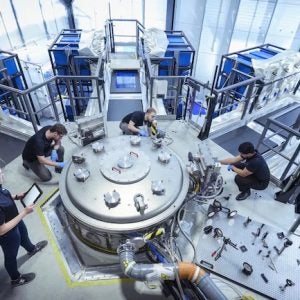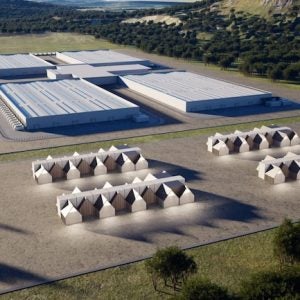 Workers at Ukraine’s Khmelnitsky NPP have poured a symbolic cubic metre of concrete for two new reactors which are planned to use US Westinghouse technology and fuel. “Today we are talking about the future, we are talking about stability, we are talking about the development of nuclear energy,” said Ukrainian Energy Minister Herman Halushchenko. He added that the plans for Khmelnitsky were Ukraine’s most significant modernisation project since World War II. Also attending the ceremony were Petro Kotin, head of Ukrainian nuclear utility Energoatom; US Ambassador to Ukraine, Bridget Brink; and Westinghouse CEO Patrick Fragman.
Workers at Ukraine’s Khmelnitsky NPP have poured a symbolic cubic metre of concrete for two new reactors which are planned to use US Westinghouse technology and fuel. “Today we are talking about the future, we are talking about stability, we are talking about the development of nuclear energy,” said Ukrainian Energy Minister Herman Halushchenko. He added that the plans for Khmelnitsky were Ukraine’s most significant modernisation project since World War II. Also attending the ceremony were Petro Kotin, head of Ukrainian nuclear utility Energoatom; US Ambassador to Ukraine, Bridget Brink; and Westinghouse CEO Patrick Fragman.
The first unit would be on an “accelerated schedule”, said Fragman because Ukraine has agreed to buy heavy equipment that is ready to install. Energoatom said construction of one reactor in peacetime takes five years and with an estimated cost of more than $5bn. US Exim Bank will partly finance the project.
The two US-designed AP-1000 reactors will use Westinghouse technology while two new, Soviet-designed VVER-1000 units will be constructed using Russian-made equipment imported from Bulgaria’s cancelled Belene project. Kotin said when all six reactors are operational, the Khmelnitsky NPP will become Europe’s largest plant. Units 1&2 at the plant are VVER-1000 reactors.
Half of Ukraine’s energy is generated by its NPPs. Ukraine operates seven VVER-1000 reactors, including three at South Ukraine NPP, as well as two at Rivne NPP and the two at Khmelnitsky. Rivne NPP also operates two VVER-440 reactors. Six VVER-1000 units at the Zaporizhia NPP have been under Russian control since early March 2022. While all Ukraine’s operating reactors are of Soviet design, they are currently using nuclear fuel from the US.
"Westinghouse is our reliable strategic partner: in the development and loading of alternative fuel into VVER reactors, in the creation of a fuel production line in Ukraine, and in the construction of new power units using Westinghouse AP1000 technology,” said Kotin.
"With this event, we are opening a new stage, a new milestone in cooperation between Westinghouse and Energoatom,” said Fragman. The units that will be built here at the Khmelnitsky NPP are identical to two twin units that were recently put into operation in the state of Georgia in the United States…. This project will also create many jobs during construction, operation, repair and maintenance.”
US Ambassador Bridget Brink said: "I welcome the efforts and desire of the Government of Ukraine and the Ministry of Energy, Energoatom in the direction of the development of nuclear power industry. These units at the Khmelnitsky NPP will be the first of nine using AP1000 technology, which are planned to be built in Ukraine together with Westinghouse."
Khmelnitsky's first reactor was connected to the grid in 1987, but work on three others stopped in 1990 when unit 3 was 75% complete. Work on the second reactor restarted and it was connected to the grid in 2004 but units 3&4 remain unfinished. Reactors currently stored at Bulgaria’s cancelled Belene NPP are expected to be used to complete these units. However, talks with Bulgaria are still ongoing. Halushchenko said earlier this year that unit 3 could begin operation in as little as two and a half years, but no firm timeline has been established for any of the new reactors.
Earlier it was reported that the two planned AP1000 units (5&6) would use reactors currently in storage in the US. Energoatom said in December that “quite favourable conditions were obtained for the supply of equipment, which is already manufactured and ready for delivery”. The equipment had been manufactured for two new units at the US VC Summer NPP being built in South Carolina before the project was cancelled in the wake of Westinghouse filing for bankruptcy.
Image courtesy of Energoatom






